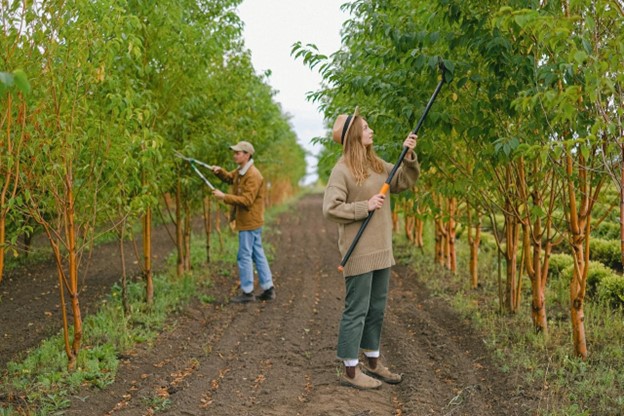With rising concerns about climate change and environmental degradation, it’s crucial to recognize the positive environmental impact linked to proper tree care. Often considered the lungs of the Earth, trees play a pivotal role in maintaining ecological balance and supporting diverse ecosystems.
Moreover, beyond their aesthetic appeal, trees offer a myriad of benefits, from purifying the air we breathe to providing habitat for countless species. With that in mind, let’s discuss the various ways in which conscientious tree care practices contribute to a healthier environment and a more sustainable future.
Promoting biodiversity
Proper tree care goes hand in hand with promoting biodiversity. Trees provide habitats and food sources for a diverse array of wildlife, including birds, insects, and mammals. By maintaining healthy and diverse tree populations, we create thriving ecosystems that support numerous species.
In addition, it’s important to recognize that each tree species contributes uniquely to ecological diversity. Preservation and responsible planting of native trees can have a significant positive impact on the local ecosystem, ensuring that the right species are in place to support the surrounding wildlife.
Trees combat air pollution
One of the most fundamental benefits of trees is their ability to produce oxygen through photosynthesis while absorbing carbon dioxide. This process plays a crucial role in combating air pollution, with trees acting as carbon sinks, isolating carbon dioxide, and mitigating the impacts of climate change.
By ensuring proper care for trees, we can enhance their capacity to perform these vital ecological functions. Trees absorb and store carbon throughout their lifespan, helping to reduce the overall concentration of greenhouse gases in the atmosphere. Regular pruning with loppers, appropriate watering, and protection from pests and diseases are essential aspects of tree care. These contribute to maintaining their health and maximizing their carbon sequestration potential.
Soil health improvement
Healthy soil is the foundation for successful tree growth and vitality. Practices, such as mulching, help improve soil structure and fertility. Mulch acts as a protective layer, preventing soil erosion, retaining moisture, and suppressing weeds. These benefits not only enhance the health of the trees themselves but also contribute to the overall well-being of the surrounding environment.
Regular soil testing and changes based on the results are crucial for ensuring that trees receive the necessary nutrients. This proactive approach to soil health promotes sustainable tree growth, reduces the need for synthetic fertilizers, and minimizes the environmental impact associated with conventional landscaping practices.
Trees’ role in water conservation
Efficient water use is a critical aspect of responsible tree care. Over-watering can lead to water wastage and create unfavorable conditions for both trees and the surrounding environment. Implementing smart irrigation systems, such as drip irrigation, and mulching to retain soil moisture are effective strategies for conserving water while ensuring trees receive adequate hydration.
Water conservation in tree care not only benefits the trees themselves but also contributes to broader efforts to address water scarcity issues. Adopting sustainable watering practices plays a part in building resilient ecosystems that can withstand changing climate conditions.
Trees as urban heat coolers
In the cities and other urban areas, the heat island effect can lead to elevated temperatures and adverse environmental conditions. Trees, with their shade and cooling properties, play a crucial role in mitigating this effect. Proper care practices to maintain healthy canopies contribute to maximizing the shade coverage provided by urban trees.
Also, strategic urban tree planting and maintenance can significantly lower temperatures in built-up areas, reducing energy consumption for cooling and improving overall livability. Recognizing the connection between proper tree care and urban heat island mitigation is essential for sustainable urban planning and design.
Economic and social benefits of trees
Beyond their environmental contributions, trees offer numerous economic and social benefits to communities. Well-maintained trees enhance property values, contribute to energy savings through shading, and create attractive green spaces that improve the overall quality of life. Community engagement in tree care initiatives fosters a sense of environmental responsibility and strengthens social bonds.
Furthermore, municipalities and businesses can invest in tree care programs that not only beautify urban landscapes but also contribute to economic prosperity and community well-being. The connection between these environmental, economic, and social factors can be essential for creating sustainable and resilient communities.
Serving as effective stormwater management
Trees play an essential role in stormwater management by absorbing and slowing down rainfall. The root systems of trees help prevent soil erosion and reduce the risk of flooding.
In urban areas, where impervious surfaces can exacerbate stormwater runoff issues, integrating trees into green infrastructure becomes increasingly important. By incorporating trees into stormwater management plans, communities can enhance their resilience to extreme weather events and enjoy additional environmental benefits.
Trees help energy conservation
Strategic tree planting and maintenance contribute to energy conservation by providing natural shade and windbreaks. Deciduous trees strategically placed around buildings can reduce cooling costs in the summer by blocking the sun’s rays while allowing sunlight to penetrate during the winter months. Proper pruning and shaping of trees ensure that they do not interfere with buildings or utility lines, promoting safe and sustainable energy practices.
In addition to reducing energy consumption, well-planned tree care contributes to the longevity of urban infrastructure, minimizing the need for repairs and replacements. This holistic approach to urban planning considers the long-term benefits of trees in creating energy-efficient and resilient communities.
Cultural and aesthetic value of trees
Trees hold significant cultural and aesthetic value, contributing to the identity and character of landscapes. Proper tree care involves preserving and celebrating the unique cultural heritage associated with certain tree species. Additionally, aesthetic considerations, such as appropriate trimming and landscaping, enhance the visual appeal of urban and natural environments.
Communities that invest in the proper care of iconic or culturally significant trees not only preserve their historical value but also create distinctive and memorable landscapes. This cultural connection to trees fosters a sense of pride and identity, reinforcing the importance of responsible tree care in preserving heritage and promoting aesthetic appreciation.
All in all
The positive environmental impact linked to proper tree care goes beyond mere aesthetics. Trees are powerful resources to fight against climate change, biodiversity loss, and environmental degradation. The benefits of their proper care are various and contribute to creating healthier, more sustainable ecosystems. In a nutshell, the care of trees is not just a choice, but an investment in a greener, more promising future.


